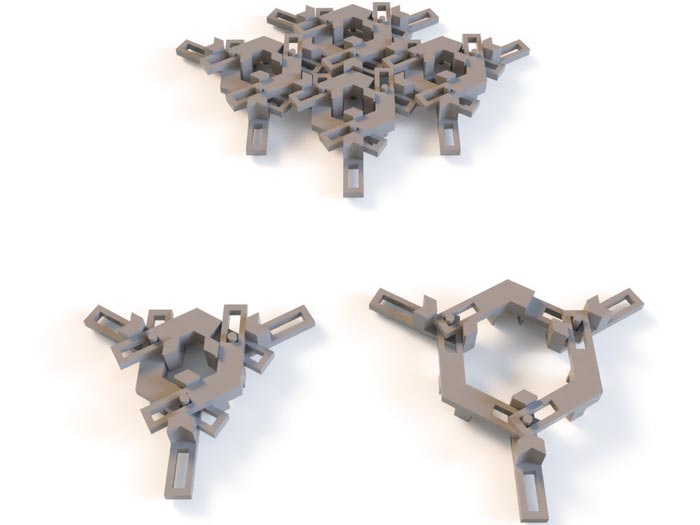The first topological acoustic transistor

Model of a honeycomb lattice that can be rapidly expanded using SMA coils to create a high thermal expansion coefficient.
Credit: Hoffman Lab/Harvard SEAS
Sound waves may pave the way for topological electronic transistors.
Topological materials move electrons along their surface and edges without any loss, making them promising materials for dissipationless, high-efficiency electronics. Researchers are especially interested in using these materials as transistors, the backbone of all modern electronics. But there’s a problem: Transistors switch electronic current on and off, but it’s difficult to turn off the dissipationless flow of electrons in topological materials.
Now, Harvard University researchers have designed and simulated the first topological acoustic transistors — with sound waves instead of electrons — and proposed a connection architecture to form a universal logic gate that can switch the flow of sound on and off.
“Since the advent of topological materials around 2007, there has been a lot of interest in developing a topological electronic transistor,” said Jenny Hoffman, the Clowes Professor of Science at the Harvard John A. Paulson School of Engineering and Applied Sciences (SEAS) and the Department of Physics. “Although the materials we used won’t yield an electronic topological transistor, our general design process applies to both quantum materials and photonic crystals, raising hopes that electronic and optical equivalents may not be far behind.”
The research is published in Physical Review Letters.
By using acoustic topological insulators, the researchers were able to sidestep the complicated quantum mechanics of electron topological insulators.
“The equations for sound waves are exactly solvable, which allowed us to numerically find just the right combination of materials to design a topological acoustic waveguide that turns on when heated, and off when cooled,” said Harris Pirie, a former graduate student in the Department of Physics and first author of the paper.
Pirie is currently a Marie Curie Postdoctoral Fellow at Oxford University.
The researchers used a honeycomb lattice of steel pillars anchored to a high-thermal-expansion plate, sealed in an air-tight box. The lattice has slightly larger pillars on one half, and slightly smaller pillars on the other half. These differences in size and spacing of the pillars determine the topology of the lattice, whether sound waves can travel along a designated channel or not. The researchers then designed a second device that converts ultrasound into heat.
The heat expands the pillar lattice and changes the topology of the waveguide. When coupled together, these two devices allow the output of one waveguide to control the state of the next, just as the electrons flowing in a conventional transistor can toggle other transistors.
These acoustic topological switches are scalable, meaning the same design used with ultrasonic frequencies at the centimeter scale could also work at sub-millimeter sizes and frequencies commonly used to transmit surface acoustic waves, which may help to overcome limitations in integrated phononic circuits.
“The control of topologically protected acoustic transport has applications in a number of important fields including efficient acoustic-noise reduction, one-way acoustic propagation, ultrasound imaging, echolocation, acoustic cloaking, and acoustic communications,” said Pirie.
These acoustic metamaterials could also be used as a teaching tool.
“Unlike quantum-mechanical systems, acoustic metamaterials are straightforward, tangible, and intuitive. They serve as an accessible entry point to cutting edge topics in condensed matter physics, including topological insulators,” said Hoffman.
The team plans to make a public-facing demonstration of these devices that students or museum visitors can touch, toggle, and hear.
The research was co-authored by Harvard undergraduates Shuvom Sadhuka and Radu Andrei, as well as MIT graduate student Jennifer Wang. It was supported in part by the Science and Technology Center for Integrated Quantum Materials under the National Science Foundation grant No. DMR-1231319.
Journal: Physical Review Letters
DOI: 10.1103/PhysRevLett.128.015501
Media Contact
Leah Burrows
Harvard John A. Paulson School of Engineering and Applied Sciences
lburrows@seas.harvard.edu
Office: 617-496-1351
Media Contact
All latest news from the category: Physics and Astronomy
This area deals with the fundamental laws and building blocks of nature and how they interact, the properties and the behavior of matter, and research into space and time and their structures.
innovations-report provides in-depth reports and articles on subjects such as astrophysics, laser technologies, nuclear, quantum, particle and solid-state physics, nanotechnologies, planetary research and findings (Mars, Venus) and developments related to the Hubble Telescope.
Newest articles

First-of-its-kind study uses remote sensing to monitor plastic debris in rivers and lakes
Remote sensing creates a cost-effective solution to monitoring plastic pollution. A first-of-its-kind study from researchers at the University of Minnesota Twin Cities shows how remote sensing can help monitor and…

Laser-based artificial neuron mimics nerve cell functions at lightning speed
With a processing speed a billion times faster than nature, chip-based laser neuron could help advance AI tasks such as pattern recognition and sequence prediction. Researchers have developed a laser-based…

Optimising the processing of plastic waste
Just one look in the yellow bin reveals a colourful jumble of different types of plastic. However, the purer and more uniform plastic waste is, the easier it is to…


